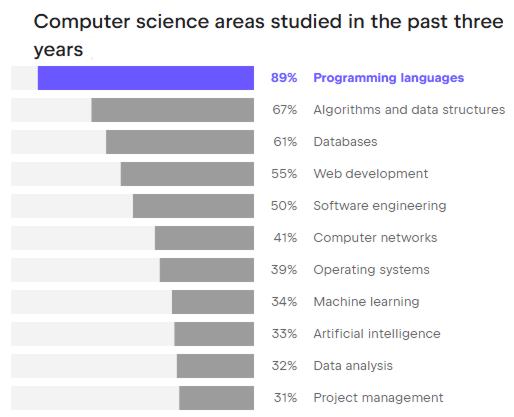| Insights Into Learning Computer Science |
| Written by Sue Gee | |||
| Wednesday, 18 December 2024 | |||
|
JetBrains Academy has published the results of a worldwide survey that set out to discover current trends in computer science education and the challenges involved in studying computer science. It also has interesting insights into how the use of AI Assistants varies across regions. More than 28,500 people took part in the Computer Science Learning Curve Survey 2024 but this number was reduced to 23,991 once the data had been cleaned. This exercise eliminated multiple responses from the same email address, responses that were below the age limit of 18 years or from individuals who hadn't studied computer science in the previous 12 months and also rejected entries from those who made impossible or extravagant claims such as being under 21 with 11 or more years of professional coding. Respondents included university students, online learners, self-taught enthusiasts, coding boot camp graduates, professionals, and career switchers. The report reveals that computer science learners are predominantly under 30 (69%), male (84%), single (62%), and without children (80%). The survey found that just over half of computer science learners study at formal educational institutions, with 54% of formal learners broadening their knowledge through further self-education. It also revealed that 78% of those who have completed formal education hold a bachelor's degree or higher. Computer science was the major field of study for almost half the respondents, followed by software engineering with 16%.
Programming languages, Algorithms & data structures and Databases are the most popular choice for learners. AI and machine learning were also popular fields, with 33% and 34% of learners exploring them, respectively. The survey also asked what learners wanted to explore in their next course in an open-ended question and ChatGPT was used to automate the analysis and sorting of the responses into thematic clusters. Top of the list came artificial intelligence, machine learning, data science (28%) followed by programming languages (13%). Turning to learning challenges, the survey reports that 64% of computer science learners have quit a course, with self-paced online tutorials and free MOOCs being the most commonly abandoned. The most common reasons cited as unengaging content, time constraints, and lack of practical exercises. The most challenging aspects of studying computer science were reported as understanding abstract and complex concepts (51%) and poor documentation or a lack thereof (40%). Other factors causing learners to struggle were practical hurdles like debugging and choosing the right resources, as well as emotional barriers like imposter syndrome and isolation. According to the report learners of all ages rely on various resources for help. Google is the top choice for all ages, while AI assistants like ChatGPT are especially popular among younger users, with two-thirds of those under 29 using them. Younger learners also tend to seek help from friends and educators, while those in their 30s and 40s turn to colleagues. YouTube is widely used across all ages, while older learners prefer textbooks and platforms like Medium. Overall, younger generations balance AI, peer support, and educational media, while older groups favor professional networks, structured articles, and textbooks. 67% of respondents report using AI assistants with ChatGPT being overwhelmingly the most popular: 62% of respondents use AI assistant functionality for explaining code and 60% for generating code. Text summarization (37%) and generating code comments, documentation, or commit messages (35%) are the next most popular uses. Delving deeper into the regional variation in reliance on AI assistance, the report comments: AI helps learners overcome language barriers. Given that English is the dominant language for most computer science resources, regions with diverse languages or primarily non-English-speaking populations depend more on translation and pronunciation functionality. The highest reliance on these features is seen in Northern Eurasia (44%) and Turkey (45%), followed closely by South and East Asia, Latin America, and Southeast Asia and Oceania (in these regions the share of such functionality usage varies from 40% to 44%). In contrast, predominantly English-speaking countries like the United Kingdom, Canada, and the United States exhibit much lower levels of usage (13%–19%), reflecting fewer language-related challenges for learners. More InformationComputer Science Learning Curve Survey 2024 Report Related ArticlesJetBrains Announces Academy AI Festival Learn To Code with JetBrains Academy To be informed about new articles on I Programmer, sign up for our weekly newsletter, subscribe to the RSS feed and follow us on Twitter, Facebook or Linkedin.
Comments
or email your comment to: comments@i-programmer.info |
|||
| Last Updated ( Wednesday, 18 December 2024 ) |






